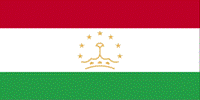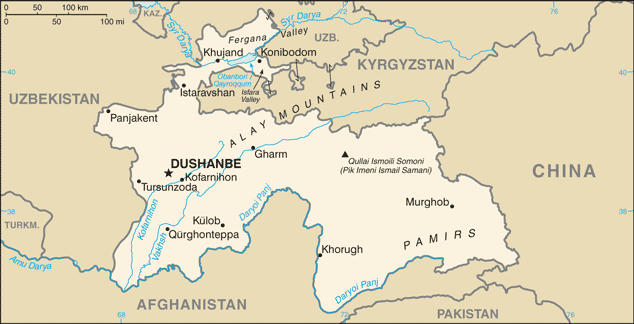Oct 9 2012
Topics Covered
Welcome to Tajikistan
Overview of Resources
Industrial Minerals
Metals
Investment
Sources
Welcome to Tajikistan
Tajikistan, with a total population of 7,768,385 as of July 2012, is located in Central Asia, to the west of China, and south of Kyrgyzstan. The country mostly has a midlatitude continental climate and covers a total area of 143,100 km2.
 |
The national flag of Tajikistan.
Image Credit: CIA Factbook. |
Tajikistan gained its independence from Russia in 1991 and from 1992 to 1997 the country experienced civil war between many religious groups. This civil war led to intense weakening of the country’s already depreciating economic status and also led to a steep fall in production of agricultural and industrial commodities.
The country’s per capita GDP seems to be the lowest among that of the former Soviet republics. Tajikistan’s GDP as of 2011 was $16.43 billion and its economic condition is very unstable due to corruption, external debts, lack of proper execution of structural reforms and power shortages.
Overview of Resources
Tajikistan’s key natural resources include petroleum, gold, uranium, silver, tungsten, zinc and lead. The country also has natural gas, oil and coal reserves and more than 400 mineral deposits. In 2010, the country experienced an increase in its production of coal, gold, natural gas and cement. Coal increased by 13.4%, cement by 47.8%, gold by 50.6% and natural gas, by 18.8%.
The political and economic issues in Tajikistan have affected the country’s mining sector that has recently experienced a very steep decline.
Industrial Minerals
Cement production in Tajikistan increased tremendously from 2000 to 2010. Although Tajikistan was not a significant cement producer, the country still managed to produce 50,000 t of cement in 2000 and 288,200 t of cement in 2010. A total of 10 cement plants are active in Tajikistan .
In 2011, an Iranian company invested almost $300 million towards the construction of two cement plants in Tajikistan. This plant is expected to produce cement amounting to 2 Mt/yr.

The map of Tajikistan. Image Credit: CIA Factbook
Metals
Tajikistan’s aluminum output in 2010 amounted to only 348,850 t which indeed was a 3% decrease in comparison with the country’s 2009 aluminum output. Insufficiently qualified personnel and aging equipment were the causes for this decrease in the production of aluminum.
Central Asia GUP TALCO (TALCO) is the only aluminum production company in Tajikistan, capable of producing 517,000 Mt of aluminum per year. In 2010, TALCO got into trouble and lost some of its engineers due to low wages.
In 2010, 1,115.2 kg of gold was produced by Tajikistan’s chief gold producer, SP Zerafshan. SP Zerafshan is keen to construct new facilities and upgrading the existing facilities and equipment.
Investment
According to experts, though Tajikistan is rich in mineral deposits, the country lacks of sufficient foreign investments. For a period of more than 10 years Tajikistan has constantly struggled to attract foreign investments, though it has one of the world’s largest silver deposit, the Kalon Konimansur silver- lead-zinc deposit and also a large number of mineral deposits.
Recent reports highlight that Tajikistan has been struggling to get bidders for its Kalon Konimansur silver-lead-zinc deposit. Experts blame the ongoing violence and corporate issues for the country’s failure to attract foreign investors.
Tajikistan has a number of unexplored mineral resources and hence stands a good chance of attracting foreign investments in order to develop these resources and improve its economic status. This significant revival in the country’s mineral and mining sectors will be effective based on the execution of suitable measures to improve the country’s infrastructure and solve issues relating to its remote location and mountainous terrain that result in high transportation costs for moving materials.
On the whole, experts feel that the future of the country’s economic status depends on proper execution of its mineral wealth and modernization of its existing mining facilities.
Disclaimer: The Author of this article does not imply any investment recommendation and some content is speculative in nature. The Author is not affiliated in any way with any companies mentioned and all statistical information is publically available.
Sources